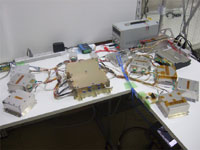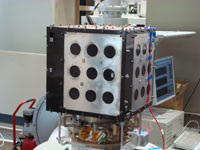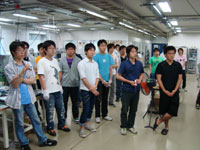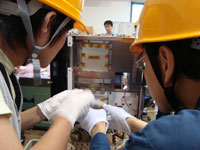| Top | News | About UNITEC-1 | Cooperation | Support us | Supporter | Contact | Links |
News
Current situation summary of Unitec-1(2010/8/10)
Sorry for not presenting the situation of UNITEC-1.
This is a current situation of UNITEC-1.
1)The operation at the first day (May 21) was able to receive the satellite beacon, but the frequency and radio field strength were unstable.
Still, some information was able to be taken out of CW that coded information to 1(with beacon) and 0(no beacon). (We will disclose examined information detailed later.)
The decipherment work is continued because the decipherment is difficult about the FSK packet (packet that sends compressed information).
The outline of the receiving situation is shown as follows(both are May 21).
| Time | Distance from the earth | Result |
|---|---|---|
| 16:38(JST)~16:40 | 180,000km | Constant beacon receiving success (Katsuura bureau) Beacon was confirmed by the sound (Tohoku University) |
| 17:38(JST)~17:40 | 200,000km | Constant beacon receiving success(Katsuura bureau) |
| 18:38(JST)~19:09 | 210,000km | Beacon received (Included information)・Decipherment success of part (Katsuura bureau, Wakayama University, Tohoku University etc.) |
| 19:40(JST)~19:42 | 230,000km | Constant beacon receiving success (Katsuura bureau, Wakayama University etc.) |
| 20:40(JST)~20:42 | 250,000km | Constant beacon receiving success (Katsuura bureau, Wakayama University etc.) |
| 21:40(JST)~22:15 | 270,000km | Beacon received (Included information)・Decipherment success of part (Katsuura bureau, Wakayama University, Yamaguchi University etc.) |
| 22:41(JST)~22:43 | 280,000km | Constant beacon receiving success (Katsuura bureau, Wakayama University, Yamaguchi University, Tohoku University etc.) |
| 23:41(JST)~23:43 | 300,000km | Constant beacon receiving success (Katsuura bureau, Wakayama University, Yamaguchi University etc.) |
| 24:41(JST)~24:43 | 320,000km | Beacon received (Included information) (Katsuura bureau, Yamaguchi University, Tohoku University etc.) |
The operation at the first day was ended because the satellite disappeared by the shadow of the earth.
2)The beacon was not able to be received though it kept receiving until May 31 after the second day.
3)After May 31, operation was interrupted.
Because many of Receiving station is using 3m antenna, and low gain antenna is not able to receive theoretically.
The development team and the operation team examined harder about the clarification of the failure cause and the future operation policy.
4)Some hypotheses were thought. There was a possibility of breaking down because of some causes, but "Hypothesis with the possibility to be able to recovery" has come out.
- There is a possibility that a part of the decipherment result of CW that was able to be taken at the first day shows the satellite is very low temperature.
- The explanation that the beacon was not able to be taken after that attaches because it became a low temperature by having gone away from the sun more than the first day.
- As a result of a detailed thermal analysis, the possibility of becoming a low temperature turned out.
As one hypothesis for the above-mentioned reasons, The first day became unstable the electric wave, and after the next day that became a low temperature in addition, became a situation in which the electric wave stopped because it was not able to supply the electric power enough to the transmitter because of the low temperature in the satellite (especially, battery).
5)The plan to execute operation again with 34m antenna is being settled on in the latter half of August when the satellite approaches the sun and the temperature situation is improved.
We will open the operation plan for the future to the public on the website as soon as it is possible to plan.
First of all, we inform you that we believe the electric wave revives, and began to act.
Data reception situation from Unitec-1(2010/6/14)
The signal was received in each bureau on May 21 after the launch, and a lot of telemetry data was accumulated. The content of data is being analyzed now. If the content is extracted, this site will open it to the public.
It inquires into the cause in the situation in which the electric wave cannot be received and it searches for the orbit and the frequency now. This site will report when there is progress.
Photograph immediately before Unitec-1 launch(2010/6/14)
These are The photograph immediately before the UNITEC-1 launch. (cooperation: JAXA/MHI)
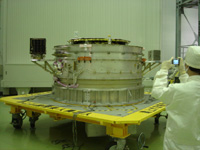
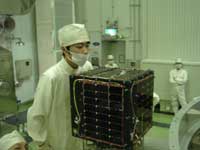
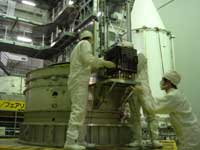
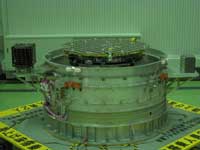
UNITEC-1, pet name announcement & launch success!(2010/5/21)
UNITEC-1(pet name "SHIN-EN") launch success on May 21!
UNITEC-1 launch postponement(2010/5/18)
The launch of the 17th H-IIA rocket machine that had been scheduled on Tuesday, May 18 was postponed.
The schedule for next time becomes 6:58:22, May 21, 2010.
New Launch Day of Venus Climate Orbiter 'AKATSUKI' (PLANET-C) by H-IIA Launch Vehicle No. 17 (source:JAXA)
Unitec-1 Send-off party(2010/4/15)
The send-off party of UNITEC-1 was held in The University of Tokyo on Sunday, April 11.
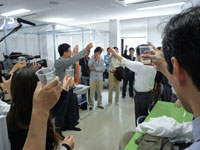
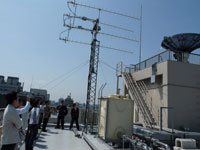
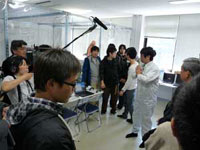
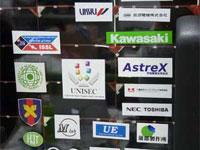
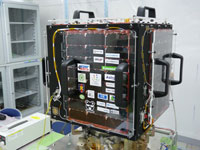
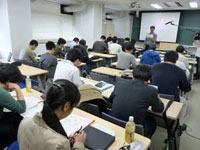
Unitec-1 Send-off party holding schedule(2010/4/9)
The send-off party of UNITEC-1 is scheduled to be held on Sunday, April 11.
UNITEC-1 Communication examination passing!(2010/4/9)
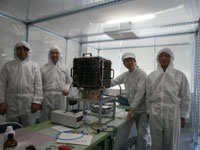 UNITEC-1 passed the communication examination by electric wave Administration Bureau.
UNITEC-1 passed the communication examination by electric wave Administration Bureau.
"Pet name of UNITEC-1" site is open!(2010/3/23)
Pet name of UNITEC-1 site is open.
The pet name of UNITEC-1 is recruited. It closes arriving before 23:59:59, March 31, 2010 in Japan Standard Time.
Pet name of UNITEC-1(in Japanese.)
This application is limited only to the UNISEC member.
"UNITEC-1" launch date set!(2010/3/4)
The launch time and day of the H-IIA Launch Vehicle No. 17 (H-IIA F17) has been set for 6:44:14 a.m. on May 18.
UNITEC-1 will be carried by the H-IIA with the Venus Climate Orbiter "AKATSUKI," the Small Solar Power Sail Demonstrator "IKAROS," and three other nano-satellites of Waseda Univ, Soka Univ and Kagoshima Univ.
Launch Day of the H-IIA Launch Vehicle No. 17(source:JAXA)
All test ended safely!(2010/2/25)
UNITEC-1 cleared all test from February 18th. Damage is not in the structure. And either the electron system works well. The main test ended everything.
It carries for JAXA In Osaka from ISAS on March 1, and the satellite baking is done on March 2 and 3. Afterwards, it returns to The University of Tokyo again on the fourth, and the last brush up is executed.
Completion of FM of Unitec-1!(2010/2/18)
Flight Model of UNITEC-1 was finally completed on February 18th 7:00AM.
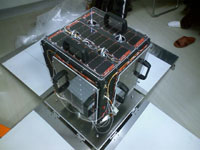
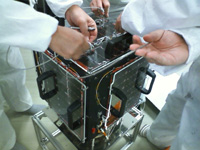
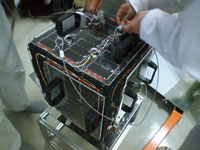
"The message for UNITEC-1" site is open!(2010/2/16)
The message for UNITEC-1 site is open.
Message is first-come-first-served basis. And closes arriving before 23:59:59, March 7, 2010 in Japan Standard Time.
If you want, hurry up!
The deadline has been extended! (postscript on March 3)
The message for UNITEC-1(in Japanese.)
UNITEC-1 GSN(Ground Station Network) Meeting(2009/11/28)
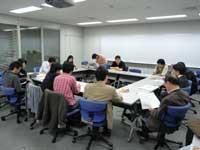 UNITEC-1 GSN Meeting was held on Nov 28 in UNISEC Workshop.
UNITEC-1 GSN Meeting was held on Nov 28 in UNISEC Workshop.
And activity report of UNITEC-1 was done in that Workshop.
Please see from the following links the report done in the UNISEC Workshop.(in Japanese)
![]() Satellite of riding together to Venus"UNITEC-1"
Satellite of riding together to Venus"UNITEC-1"
![]() GSN project for UNITEC-1 support
GSN project for UNITEC-1 support
![]() The future of UOBC competition
The future of UOBC competition
UNITEC-1 CDR(2009/11/04)
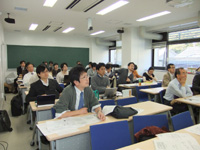 UNITEC-1 CDR was done in The University of Tokyo on November 3.
UNITEC-1 CDR was done in The University of Tokyo on November 3.
More than 30 people participated from Hokkaido to Kyushu, and it was discussed aiming at next year's launch.
EM vibration test(in Hokkaido Industrial Research Institute)(2009/10/09)
EM assembly(in Hokkaido Industrial Research Institute)(2009/10/05~08)
Tablesat EM completion(Electric examination. in Tokyo Univ, of Science)(2009/09/28~10/02)
STM vibration test(in Hokkaido Industrial Research Institute)(2009/09/16~18)
EM fit check(in Uematsu Electric Co,.Ltd)(2009/09/14~15)
EM fit check(in Aichi Univ, of Technology)(2009/09/07~12)
Unitec-1 Qualification Round: Six Groups Selected(2009/08/17)
The OBCs for UNITEC-1 satellite were selected on Aug 13 at Kyushuu Institute of Technology. Winners: Tokyo University of Science, Hokkaido Inst. of Tech., Kouchi Inst. of Tech, Tohoku Univ., the University of Electro-Communications, and Keio Univ. The six universities also won AXELSPACE Award (50,000 Yen).
University OBC competition and vibration test on summer(in Kyushu Institute of Technology)(2009/08/10~14)
| Sitemap | Copyright (C) 2008-2010 University Space Engineering Consortium, All Rights Reserved. |

